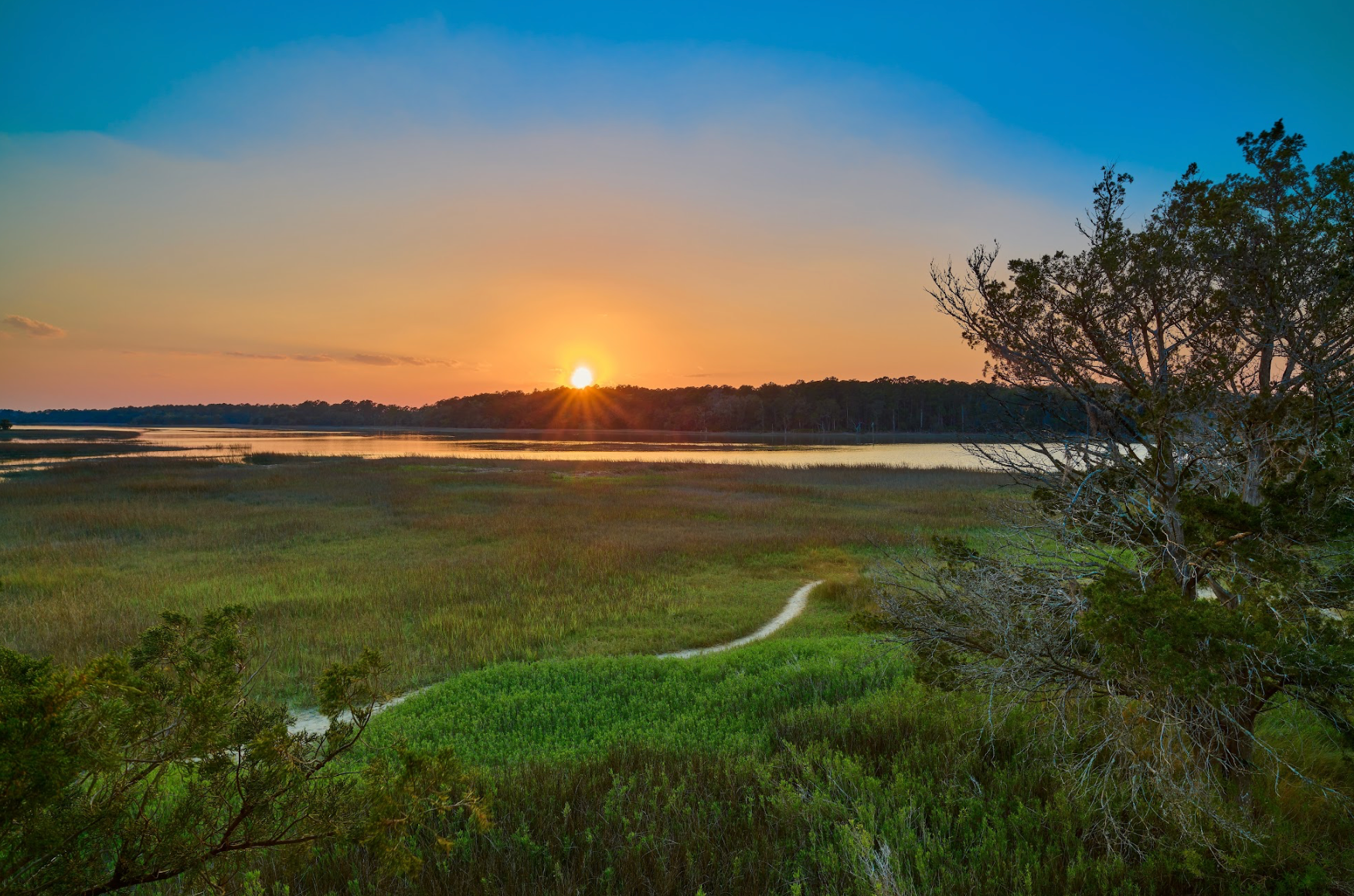Marshlight Moments: Savannah’s Kessler I Sunset Cruise
A handcrafted wooden boat, a storied river, and the soft glow of Savannah’s golden hour—slow travel at its most satisfying.
The Savannah River drifts like a quiet conversation at day’s end, carrying the scent of salt and sawgrass toward the sea. You step aboard the Kessler I—a polished wooden Ditchburn that looks as if it slid from a sepia photograph—and the river greets you with a gentle shoulder. Lines slip from the cleats, the bow noses into the current, and the city’s historic brick and ironwork retreat into a soft watercolor along the bluffs. Overhead, the Talmadge Memorial Bridge arcs like a wishbone. A container ship glides by with the presence of a moving city block, the river urging it along while pelicans draft its wake. This is what the afternoon looks like on Savannah’s waterway; by sunset, the marsh will catch fire in copper and rose, and the day will fold itself neatly into evening.
Trail Wisdom
Layer For The Breeze
Even warm days feel cooler on the water. Pack a light windbreaker or wrap so you can enjoy the deck without the chill.
Eyes On The Edges
Scan the marsh grass for egrets and the channel edges for dolphin fins; wildlife often hugs the transitions.
Footing Matters
Wear non-slip, non-marking soles—polished wood can be slick, especially after a passing shower or spray.
Choose Your Light
Book afternoon for crisp views and port action; pick sunset for softer colors and mirror-like reflections.
Local Knowledge
Hidden Gems
- •Savannah Belles Ferry: take the free ferry across the river for skyline views before or after your cruise
- •Old Fort Jackson: time your afternoon to catch a historic cannon firing from riverside ramparts
Wildlife
Bottlenose dolphin, Osprey and great egret
Conservation Note
Georgia’s tidal marsh is a critical nursery for coastal species—keep a respectful distance from wildlife and avoid single-use plastics that can enter the estuary.
Founded in 1733, Savannah grew around this river, which later powered a global cotton trade and remains one of America’s busiest ports.
Seasonal Guide
spring
Best for: Birdwatching, Mild temperatures
Challenges: Pollen, Breezy afternoons
Fresh green marsh, active birdlife, and comfortable temps make spring a sweet spot before summer humidity arrives.
summer
Best for: Long daylight, Dolphin sightings
Challenges: Heat and humidity, Pop-up thunderstorms and biting insects
Expect hot, bright days and sudden showers; sunset cruises are cooler and often more comfortable.
fall
Best for: Clear skies, Golden-hour photography
Challenges: Occasional late-season storms, Cool breezes after sunset
Dry air and blazing sunsets define fall; bring a layer and enjoy calmer water and fewer crowds.
winter
Best for: Crowd-free cruising, Migratory bird viewing
Challenges: Chilly wind, Short daylight
Crisp, quiet days deliver reflective water and great visibility; dress warmly and savor the slower season.
Photographer's Notes
What to Bring
Light WindbreakerEssential
Water amplifies wind; a thin layer keeps you comfortable in changing conditions.
Polarized SunglassesEssential
Polarization cuts glare off the river, improving wildlife spotting and photo clarity.
Non-Slip Deck ShoesEssential
Grippy, non-marking soles help on smooth wooden decks and keep the boat looking sharp.
Compact Binoculars
Great for tracking ospreys, herons, and distant dolphins along the marsh edge.
Common Questions
What’s included with the cruise?
A curated selection of artisan delicacies is served onboard, paired with a glass of Kessler wine or a cold beer. Additional beverages may be available for purchase depending on the sailing.
Is the Kessler I covered or open-air?
The vessel features open-air deck space to enjoy the breeze and views; portions may be shaded but expect exposure to sun and wind.
What happens in bad weather?
Sailings may be adjusted or canceled for safety during strong storms or high winds. If weather impacts your departure, the operator will communicate options for rescheduling or refunds.
Are children welcome on this cruise?
Yes, family-friendly sailings are common, though the atmosphere is relaxed and adult-oriented. Guests must be 21+ to consume alcoholic beverages; bring a valid ID.
Is there a restroom onboard?
A small marine head may be available; it’s still smart to use facilities before boarding due to the boat’s intimate size.
Where do I meet the boat and is parking available?
Departures are typically from the riverfront in Savannah’s Historic District; paid garages and street parking are nearby. Exact meeting details are provided after booking.
What to Pack
Polarized sunglasses for glare-free views; light windbreaker for the marine breeze; non-slip deck shoes for safe footing on wood; compact binoculars to spot dolphins and marsh birds.
Did You Know
Georgia’s coast contains roughly 368,000 acres of salt marsh—the largest contiguous expanse on the U.S. East Coast.
Quick Travel Tips
Arrive 15–20 minutes early to board without rush; garages near River Street make parking easier than the cobblestones; bring a valid ID for wine and beer service; sunset departure times shift seasonally—confirm exact check-in when booking.
Local Flavor
Post-cruise, stroll the Plant Riverside District for rooftop views at Electric Moon or Myrtle & Rose. For a memorable dinner, book Stone & Webster Chophouse or wander to Vic’s on the River. Craft beer fans can walk to Service Brewing Co., while sweet tooths should detour to Leopold’s Ice Cream on Broughton. If marsh vibes linger, head late afternoon to The Wyld Dock Bar for local seafood and sunset over the backwaters.
Logistics Snapshot
Closest airport: Savannah/Hilton Head International (SAV), ~20 minutes from the riverfront. Boarding: typically along River Street in the Historic District. Driving: 5–10 minutes from most downtown hotels; ~25–30 minutes from Tybee Island. Cell service: generally reliable along the river. Permits: none required; bring photo ID for alcohol. Accessibility: contact the operator in advance for mobility assistance when boarding.
Sustainability Note
Savannah’s estuary is a living nursery—keep voices low around wildlife, never feed dolphins or birds, and secure hats and plastic items so they don’t blow overboard. Reuse bottles where possible and follow crew guidance to minimize wake impacts along marsh edges.
